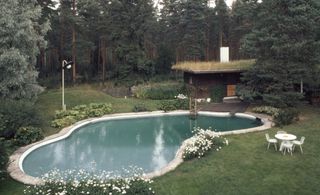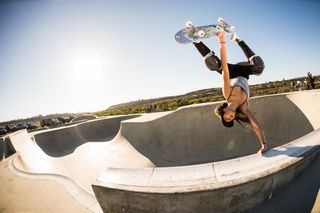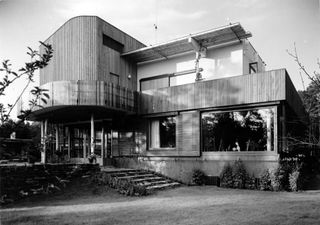A series of exhibitions exploring skateboarding in swimming pools opens this weekend at the Aalto 2 Museum Center in Jyväskylä, Finland. The show focuses on the enduring, and perhaps unexpected, legacy of Finnish modernist architecture master Alvar Aalto on skateboarding culture.
In 1939, Aalto collaborated with his wife Aino to design Villa Mairea, an experimental private house in rural southwest Finland. He incorporated a kidney-shaped concrete pool into the property. This pool has since become iconic, both as a precursor to the rise of similar mid-century pool designs, and as a structure unexpectedly adapted by American skateboarders as the perfect basin. To skate in.

Villa Mairea's iconic pool
(Image credit: Martti Kapanen © Alvar Aalto Foundation.)
“The Pool”: Skateboarding in the pool, Alvar Aalto and more
Under the banner “The Pool,” the exhibit opens with “From the Surf to the Sidewalk – When Skateboarding Culture and Architecture Meet.” The purpose is to trace how this pool design became synonymous with skateboarding culture in California, and to place Aalto's architectural work within a broader cultural and social context.
The pool at Villa Mairea is believed to be the world's first kidney-shaped pool. It was unusual for its free-flowing shape, curved bowl basin, and lack of sharp edges and corners. Almost a decade later, American landscape architect Thomas Church, who was a friend of Aalto, adopted a similar design for the pool at Donnell Gardens in Sonoma, California, in 1948 with architects Lawrence Halprin and George Rockrise. .

Skateboarder Lizzy Armanto on the move
(Image credit: Lizzy Armanto)
Introducing a radically new form to the prevailing linear style, the Donnell Garden Pool influenced a wave of architects and quickly became a symbol of modernist suburban architectural gardens focused on leisure. “This was one of the important projects of California modernism,” says exhibition curator Juho Haavisto.
By the 1970s, similar pools were dotting gardens across the state, but when the 1976 drought hit, many were left vacant. Skateboarders quickly realized that these concrete basins were perfect for skating and developing tricks, and skateboarders where the bowl and associated half-pipe are core components of practice and skatepark design. created a culture of

Villa Mairea main entrance
(Image credit: Maija_Holma, Alvar Aalto Museum)
“The built environment is physically very important to skateboarding,” Haavist says. “To move forward, you need concrete, asphalt, or a similar solid, flat surface. Some skate spots have great architecture and design, but some great locations have very practical There are also designs.”
Another exhibition in “The Pool” series is “Colors,” which explores the inclusivity of skateboarding culture through the eyes of Lizzy Armanto, an American-Finnish Olympic skateboarder who has long admired Aalto and his pool designs. I'll explore. “Pre-Aalto pools had hard edges where the floor met the walls, but Aalto added curvature,” says Armanto. “This created a perfect transition to get over the wall.”

Skateboarder Ray Barbee practices in an empty pool.
(Image credit: Ray Barbee)
Armanto believes that skateboarders and architects see the world in a similar way. “They are always looking around for new possibilities,” she says. “I feel like skateboarders are always pushing the boundaries of how they interact with their surroundings. Pools were built for swimming, but in a flurry of events they were emptied and skateboarders found them. I learned how to fly.”
Concrete Currents, also at Aalto 2, features photographic work by Finnish skateboarder and photographer Alto Saari, which features images of skaters in kidney-shaped pools around California inspired by Aalto. Contains shots of. “It was amazing to see how Aalto's designs broke down barriers and created new life forms,” says Saari. Villa Mairea's pool “ended up being more than just a swimming pool,” he added.

(Image credit: Gustaf Welin © Alvar Aalto -säätiö, Alvar Aalto Foundation-)
Aalto 2.Museum

